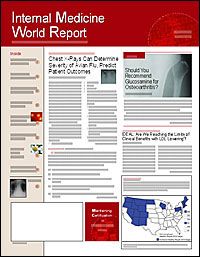New Resuscitation Guidelines Call for More Compressions, Fewer Interruptions
New cardiopulmonary resuscitation (CPR) guidelines emphasize more chest compressions, less delay in starting them, and fewer interruptions. The American Heart Association (AHA) released its latest guidelines for CPR and emergency cardiovascular care in Circulation (2005;112[suppl]: IV1-IV203).
Michael Sayre, MD, of Ohio State University, Columbus, served on the committee that wrote the guidelines, based on the work of 281 reviewers evaluating a total of 276 topics. He said the new guidelines apply to all those who perform resuscitation, including lay rescuers who do CPR. The emphasis, he said, is on the need to do good, basic CPR.
Key Changes
One major change from the previous 2000 guidelines is doing 30 chest compressions for every 2 breaths delivered. "All the high-tech interventions, such as drug administration or airway control, really depend on getting blood circulated," Dr Sayre said. No one knows if 30:2 is the optimal compression-to-ventilation ratio, but the old 15:2 ratio meant that patients could be getting compressions for only half the time. Two breaths per 30 compressions should still provide adequate oxygenation, he said.
This compression-to-ventilation ratio applies to all single rescuers and all victims, except newborns. Each breath should last 1 second and make the chest visibly rise. The guideline authors intended to simplify the CPR process so that more people could learn it and do it effectively. (For 2-rescuer CPR on a child the ratio is 15:2, since childhood cardiac arrest is often the result of asphyxia.)
Effective chest compressions of adequate rate and depth provide better blood flow as they continue. The first few compressions do not pump blood as well as subsequent ones, so interruptions are discouraged. Health care providers therefore should minimize interruptions to chest compressions (eg, for rhythm checks, inserting airways, or administering drugs), and interruptions should ideally be limited to 10 seconds. Rescuers also need to let the chest recoil fully after each compression to promote optimal refilling of the heart with blood. The rate of compressions should be 100/min.
Another key change pertains to defibrillation. A single shock, followed by immediate CPR, is now recommended, with rhythm checks every 2 minutes. Pre?viously, with automatic external defibrillators, the cycle of analyses and up to 3 shocks could delay initiation of compressions by 37 seconds.
Studies have shown that the first shock stops an abnormal rhythm in cardiac arrest >85% of the time. "If a single shock did not convert the patient out of the ventricular fibrillation that maybe? means that the heart could use some additional substrate and oxygen before we ask it to do actual work," Dr Sayre said, "so we advocate doing 2 minutes of CPR before trying a second shock."
He noted that automatic external ?defibrillators will have to be reprogrammed if they are to meet the new ?recommendations.
The sequence for a single rescuer activating the emergency response system (911) differs for adult and child victims. Since adult cardiac arrest is often the result of ventricular fibrillation, the rescuer should call emergency responders before initiating CPR so they can bring a defibrillator. For children, 2 minutes of CPR should precede calling 911.
Lay rescuers are no longer advised to check for a pulse, since they are correct in identifying one only half the time. Primary care physicians who have a heart monitor available may use it to determine asystole or ventricular fibrillation.
Get Your Patients Involved
Certain recommendations have not changed for physicians, including use of drugs to treat cardiac arrest, airway control, rate and depth of compressions, or hand positions. To learn the new guidelines physicians will be able to take updated basic or advanced cardiac life support classes, which are now in the planning stages, through the AHA.
Dr Sayre encourages physicians to teach their families CPR and to promote training to all their patients, to "help spread the word that this kind of training is not that difficult." Physicians can obtain a simple training kit from the AHA to teach CPR to their family members and patients.
"The key message for the general public is?doing nothing is going to ensure that the patient dies," Dr Sayre emphasized, "and that doing something is better than doing nothing." The full version of the new guidelines is available at www.americanheart.org/presenter.jhtml?identifier=3035517.
